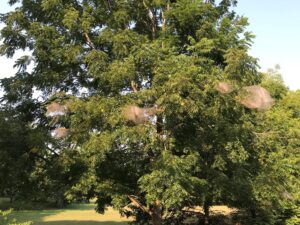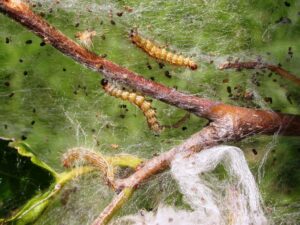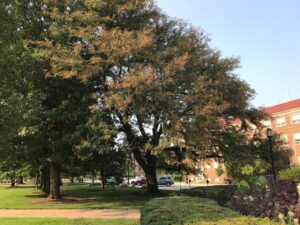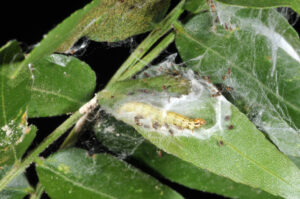Just after the browned leaves on branches of trees attacked by periodical cicadas began to disappear from view, webworms and their associated browning started to spread through the landscape. Two of the more common webworms I have been seeing are the mimosa and the fall webworm. While neither of them can outright kill trees, they are unsightly, especially at the end of the summer when substantial portions of the tree are disfigured. Treatment late in the summer does little to reduce injury, because it can be difficult to penetrate the webs with insecticides, and because most of the damage has already been done. The best course of action is to plan on managing these insects next year, when they are more easily controlled with insecticides.
Fall webworm attacks a wide range of deciduous trees including flowering fruit trees, black walnuts, elm, hickory and bald cypress. They are most common in suburban areas, roadsides and forest edges that lack the predators and parasites the webworms encounter in the forest. In June adults emerge from wintering sites to lay eggs in the canopy. Eggs hatch into caterpillars that encase branches in webs as they feed. By the end of the second generation in late August webs can cover substantial portions of trees. Caterpillars are yellowish-green with black spots and long white hairs, and grow up to 1.5″. Caterpillar feces falling from trees can be a problem during heavy infestations.
- Figure 2. Fall webworms and fecal pellets feeding in web.
- Figure 3. Brown webbing caused by the mimosa webworm is extensive on honeylocust plantings throughout the state.
Unlike fall webworm, the mimosa webworm only attacks honeylocust and mimosa trees. Leaves on ends of branches become webbed together and turn brown as lime-green caterpillars skeletonize leaf tissue. Heavily infested trees appear frosted brown. In early June, adults emerge and lay eggs on trees. First webs can be seen on ends of branches in mid-June when oak leaf hydrangea and tree lilac are in bloom. The second generation of adults fly and lay eggs starting in late July. A third generation occurs in the fall. The dangling caterpillars can be a nuisance under heavily infested trees. We are seeing an uptick in the abundance of this pest because the last two winters have not been cold enough to kill them.
Control of webworm caterpillars is best achieved if actions are taken before the trees become covered with webs. By identify trees that are heavily infested this year, you can target your efforts next spring before webbing becomes extensive. Small webs can be simply pulled off and destroyed if easy to reach, and only a small proportion of the tree is affected. Pesticides should be used when there are too many webs to make their removal practical. When foliar sprays are feasible, due to small tree size or cooperative neighbors, you can kill caterpillars biorational pesticides (spinosad, Bacillus thuringensis, or chlorantraniliprole). When sprays are not feasible, a systemic insecticide, such as acephate, dinotefuran or an injection of emamectin benzoate can be applied by a professional to control the problem.
Use the Purdue Tree Doctor app to get a diagnosis and a recommendation for webworms and other pests.



